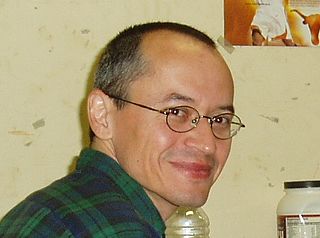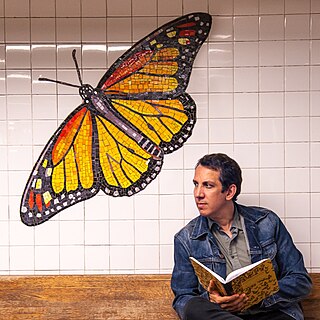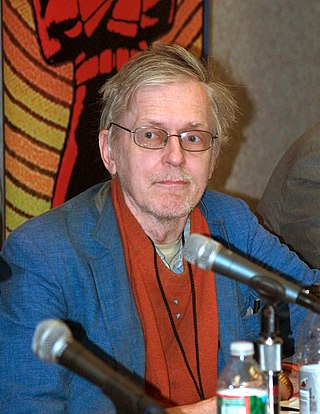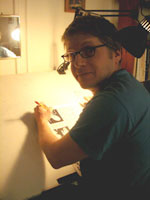A graphic novel is a long-form work of sequential art. The term graphic novel is often applied broadly, including fiction, non-fiction, and anthologized work, though this practice is highly contested by comics scholars and industry professionals. It is, at least in the United States, typically distinct from the term comic book, which is generally used for comics periodicals and trade paperbacks.

Joe Sacco is a Maltese-American cartoonist and journalist. He is best known for his comics journalism, in particular in the books Palestine (1996) and Footnotes in Gaza (2009), on Israeli–Palestinian relations; and Safe Area Goražde (2000) and The Fixer (2003) on the Bosnian War. In 2020, Sacco released Paying the Land, published by Henry Holt and Company.

Boleslav William Felix Robert Sienkiewicz is an American artist known for his work in comic books—particularly for Marvel Comics' New Mutants, Moon Knight, and Elektra: Assassin. He is the co-creator of the character David Haller / Legion, the basis for the FX television series Legion.

Peter Kuper is an American alternative comics artist and illustrator, best known for his autobiographical, political, and social observations.

A Contract with God and Other Tenement Stories is a graphic novel by American cartoonist Will Eisner published in 1978. The book's short story cycle revolves around poor Jewish characters who live in a tenement in New York City. Eisner produced two sequels set in the same tenement: A Life Force in 1988, and Dropsie Avenue in 1995. Though the term "graphic novel" did not originate with Eisner, the book is credited with popularizing its use.

Ryan North is a Canadian writer and computer programmer.

Peter Sanderson Jr. is an American comic book critic and historian.

Brooke Gladstone is an American journalist, author and media analyst. She is the host and managing editor of the WNYC radio program On the Media.

Jason Starr is an American author, comic book writer, and screenwriter from New York City. Starr has written numerous crime fiction novels and thrillers.

Josh Neufeld is an alternative cartoonist known for his comics journalism work on subjects like graphic medicine, equity, and technology; as well as his collaborations with writers like Harvey Pekar and Brooke Gladstone. He is the writer/artist of A.D.: New Orleans After the Deluge, and the illustrator of The Influencing Machine: Brooke Gladstone on the Media.
The New Adventures of Queen Victoria is a daily webcomic created by Pab Sungenis. It uses the photo-manipulation technique popularized by Adobe Photoshop and other image editing programs to insert actual photographs and paintings of the characters into situations, instead of more conventional methods. It was syndicated online by GoComics, a division of Andrews McMeel Universal, and has been collected into six trade paperback editions.

Derek McCulloch is a writer, known for graphic novels such as Stagger Lee, Gone to Amerikay, Pug, and Displaced Persons. He was born in Ottawa, Ontario, raised in Grande Prairie, Alberta, and lives in Oakland, California.
Mark Andrew Smith is an American comic book author and graphic novelist.

A.D.: New Orleans After the Deluge is a non-fiction graphic novel by cartoonist Josh Neufeld. Originally published as a webcomic, A.D. tells the stories of a handful of real-life New Orleans residents and their experiences during and after Hurricane Katrina. The graphic novel was a New York Times best-seller and was nominated for an Eisner Award and a Harvey Award in 2010. In addition, A.D. was selected for inclusion in The Best American Comics 2010.

Noah Van Sciver is an independent American cartoonist who resides in Columbia, South Carolina.

Jim Rugg is an American cartoonist and illustrator from Pittsburgh known for his tongue-in-cheek evocation of 1970s-era comics and pop culture. His graphic novels and comics collections include Street Angel, Afrodisiac, The P.L.A.I.N. Janes and Janes in Love, One Model Nation, and The Guild.

Comics journalism is a form of journalism that covers news or nonfiction events using the framework of comics, a combination of words and drawn images. Typically, sources are actual people featured in each story, and word balloons are actual quotes. The term "comics journalism" was coined by one of its most notable practitioners, Joe Sacco. Other terms for the practice include "graphic journalism," "comic strip journalism", "cartoon journalism", "cartoon reporting", "comics reportage", "journalistic comics", "sequential reportage," and "sketchbook reports".
Comics has developed specialized terminology. Several attempts have been made to formalize and define the terminology of comics by authors such as Will Eisner, Scott McCloud, R. C. Harvey and Dylan Horrocks. Much of the terminology in English is under dispute, so this page will list and describe the most common terms used in comics.

David Schraven is a German journalist. From 2010 to 2014, he was head of investigations at Funke Mediengruppe. From 2007 to September 2014, he was treasurer of German association of investigative journalists Netzwerk Recherche. In 2014 he founded Correctiv.
Karen Berger is an American writer, long-distance backpacker, and speaker. She is the author of adventure narratives, guidebooks, instructional books, and essays about the U.S. national scenic and historic trails, worldwide trails, and hiking and backpacking skills and techniques.















